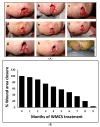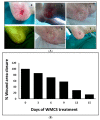Wireless Direct Microampere Current in Wound Healing: Clinical and Immunohistological Data from Two Single Case Reports
- PMID: 31492004
- PMCID: PMC6784371
- DOI: 10.3390/bios9030107
Wireless Direct Microampere Current in Wound Healing: Clinical and Immunohistological Data from Two Single Case Reports
Abstract
Chronic pressure ulcers are hard-to-heal wounds that decrease the patient's quality of life. Wireless Micro Current Stimulation (WMCS) is an innovative, non-invasive, similar to electrode-based electrostimulation (ES) technology, that generates and transfers ions that are negatively-charged to the injured tissue, using accessible air gases as a transfer medium. WMCS is capable of generating similar tissue potentials, as electrode-based ES, for injured tissue. Here, through immunohistochemistry, we intended to characterize the induced tissue healing biological mechanisms that occur during WMCS therapy. Two single cases of bedridden due to serious stroke white men with chronic non-healing pressure ulcers have been treated with WMCS technology. WMCS suppresses inflammatory responses by decreasing the aggregation of granulocytes, followed by stimulating myofibroblastic activity and a new formation of collagen fibers, as depicted by immunohistochemistry. As a result, WMCS provides a special adjunct or stand-alone therapy choice for chronic and non-healing injuries, similar to electrode-based ES, but with added (i.e., contactless) benefits towards its establishment as a routine clinical wound healing regime.
Keywords: chronic wounds; direct microcurrent; electrical stimulation; non-invasive; pressure ulcer; wireless technology.
Conflict of interest statement
The authors declare no conflict of interest.
Figures






Similar articles
-
Wireless micro current stimulation--an innovative electrical stimulation method for the treatment of patients with leg and diabetic foot ulcers.Int Wound J. 2015 Dec;12(6):693-8. doi: 10.1111/iwj.12204. Epub 2013 Dec 30. Int Wound J. 2015. PMID: 24373098 Free PMC article.
-
Wireless Micro Current Stimulation (WMCS) therapy to enhance burn wound healing: A randomized clinical trial.Burns. 2025 Feb;51(1):107286. doi: 10.1016/j.burns.2024.10.007. Epub 2024 Oct 16. Burns. 2025. PMID: 39571366 Clinical Trial.
-
Use of wireless microcurrent stimulation for the treatment of diabetes-related wounds: 2 case reports.Adv Skin Wound Care. 2013 Jan;26(1):1-4. doi: 10.1097/01.ASW.0000425942.32993.e9. Adv Skin Wound Care. 2013. PMID: 23263389
-
Hierarchical evaluation of electrical stimulation protocols for chronic wound healing: An effect size meta-analysis.Wound Repair Regen. 2017 Sep;25(5):883-891. doi: 10.1111/wrr.12594. Epub 2017 Dec 8. Wound Repair Regen. 2017. PMID: 29052946 Review.
-
Non-healing foot ulcers in diabetic patients: general and local interfering conditions and management options with advanced wound dressings.J Wound Care. 2015 Apr;24(4 Suppl):35-42. doi: 10.12968/jowc.2015.24.Sup4b.35. J Wound Care. 2015. PMID: 25853647 Review.
Cited by
-
Microcurrent Stimulation Triggers MAPK Signaling and TGF-β1 Release in Fibroblast and Osteoblast-Like Cell Lines.Cells. 2020 Aug 19;9(9):1924. doi: 10.3390/cells9091924. Cells. 2020. PMID: 32825091 Free PMC article.
-
Emulsion Electrospinning of PLLA/PVA/Chitosan with Hypericum perforatum L. as an Antibacterial Nanofibrous Wound Dressing.Gels. 2023 Apr 22;9(5):353. doi: 10.3390/gels9050353. Gels. 2023. PMID: 37232945 Free PMC article.
-
Bioadhesive Gauze Embedded with Chitosan-Butein Bioconjugate: A Redox-Active pH Sensor Platform.Biosensors (Basel). 2022 Dec 21;13(1):6. doi: 10.3390/bios13010006. Biosensors (Basel). 2022. PMID: 36671841 Free PMC article.
-
Bioelectric Sensors: On the Road for the 4.0 Diagnostics and Biomedtech Revolution.Biosensors (Basel). 2020 Aug 11;10(8):96. doi: 10.3390/bios10080096. Biosensors (Basel). 2020. PMID: 32796701 Free PMC article.
-
Development of Smart Clothing to Prevent Pressure Injuries in Bedridden Persons and/or with Severely Impaired Mobility: 4NoPressure Research Protocol.Healthcare (Basel). 2023 May 9;11(10):1361. doi: 10.3390/healthcare11101361. Healthcare (Basel). 2023. PMID: 37239647 Free PMC article.
References
Publication types
MeSH terms
LinkOut - more resources
Full Text Sources
Research Materials

